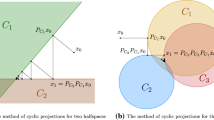Abstract
This paper describes an affine potential reduction algorithm for linear programming that simultaneously seeks feasibility and optimality. The algorithm is closely related to a similar method of Anstreicher. The new features are that we use a two-dimensional programming problem to derive better lower bounds than Anstreicher, that our direction-finding subproblem treats phase I and phase II more symmetrically, and that we do not need an initial lower bound. Our method also allows for the generation of a feasible solution (so that phase I is terminated) during the course of the iterations, and we describe two ways to encourage this behavior.
Similar content being viewed by others
References
K.M. Anstreicher, “A monotonic projective algorithm for fractional linear programming”Algorithmica 1 (1986) 483–498.
K.M. Anstreicher, “A combined phase I—phase II projective algorithm for linear programming,”Mathematical Programming 43 (1989) 209–223.
K.M. Anstreicher, “A combined phase I—phase II scaled potential algorithm for linear programming,” CORE Discussion Paper 8939, CORE Catholic University of Louvain, Belgium, 1989.
K.M. Anstreicher, “On monotonicity in the scaled potential algorithm for linear programming,”Linear Algebra and its Applications 152 (1991) 223–232.
K.M. Anstreicher and P. Watteyne, “A family of search directions for Karmarker's algorithm,” CORE Discussion Paper 9030, CORE Catholic University of Louvain, Belgium, 1990.
C. Fraley, “Linear updates for a single-phase projective method,”Operations Research Letters 9 (1990) 169–174.
R.M. Freund, “Polynomial-time algorithms for linear programming based only on primal scaling and projected gradients of a potential function,”Mathematical Programming 51 (1991) 203–222.
R.M. Freund, “Theoretical efficiency of a shifted barrier function algorithm for linear programming,”Linear Algebra and its Aplications 152 (1991) 19–41.
R.M. Freund, “A potential-function reduction algorithm for solving a linear program directly from an infeasible ‘warm start’,”Mathematical Programming (Series B) 52 (1991) 441–466.
G. de Ghellinck and J.-P. Vial, “An extension of Karmarkar's algorithm for problems in standard form,”Mathematical Programming 37 (1987) 81–90.
P.E. Gill, W. Murray, M.A. Saunders and M.H. Wright, “Shifted barrier methods for linear programming,” Technical Report SOL 88-9, Department of Operations Research, Stanford University, 1988.
C.C. Gonzaga, “Polynomial affine algorithms for linear programming,”Mathematical Programming 49 (1990) 7–21.
N. Karmarkar, “A new polynomial time algorithm for linear programming,”Combinatorica 44 (1984) 373–395.
I. Lustig, “Feasibility issues in an interior point method for linear programming,”Mathematical Programming 49 (1990/91) 145–162.
I. Lustig, R.E. Marsten and D.F. Shanno, “Computational experience with a primal—dual interiorpoint method for linear programming,”Linear Algebra and its Applications 152 (1991) 191–222.
K.A. McShane, C.L. Monma, and D. Shanno, “An implementation of a primal—dual interior point method for linear programming,”ORSA Journal on Computing 1 (1989), 70–83.
R.A. Polyak, “Modified barrier functions (theory and methods),”Mathematical Programming 54 (1992) 177–222.
M.J. Todd, “On Anstreicher's combined phase I—phase II projective algorithm for linear programming,”Mathematical Programming 55 (1992) 1–15.
M.J. Todd and Y. Wang, “On combined phase 1—phase 2 projective methods for linear programming,” to appear inAlgorithmica.
Y. Ye, “An O(n 3 L) potential reduction algorithm for linear programming,”Mathematical Programming 50 (1991) 239–258.
Author information
Authors and Affiliations
Additional information
Research supported in part by NSF grant DMS-8904406 and by NSF, AFOSR and ONR through NSF grant DMS-8920550.
Rights and permissions
About this article
Cite this article
Todd, M.J. Combining phase I and phase II in a potential reduction algorithm for linear programming. Mathematical Programming 59, 133–150 (1993). https://doi.org/10.1007/BF01581241
Received:
Revised:
Issue Date:
DOI: https://doi.org/10.1007/BF01581241




